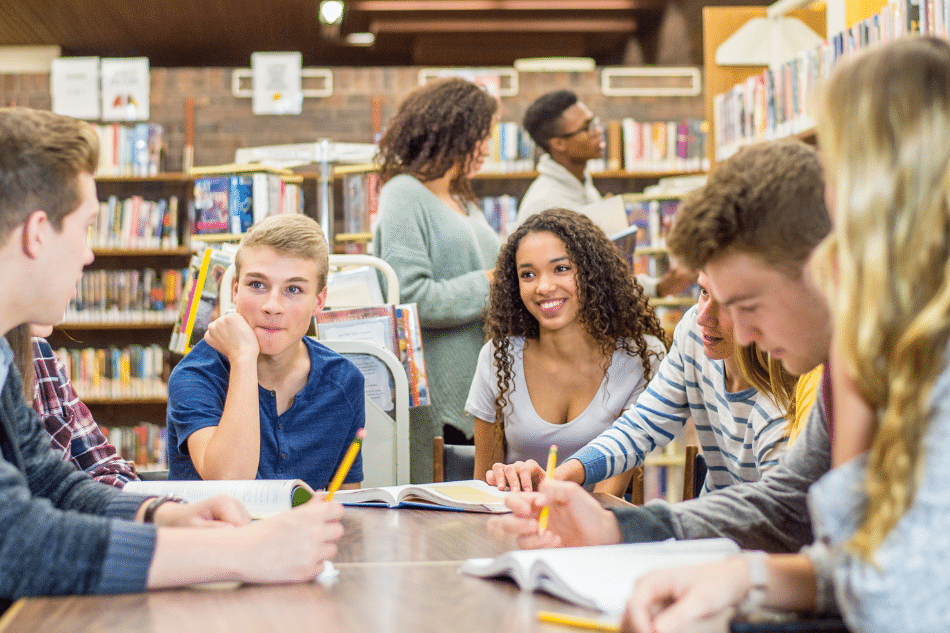Making New Friends After Every Move: Building Confidence in Military Kids

Starting over is never easy, especially for military teens. Every new base means another round of introductions, another cafeteria scan for a place to sit, and another shot at building friendships among people you’ve never met.
Studies show military families relocate or permanently change stations every two years on average, with variations depending on ongoing missions and job specialty.1 Adults may view this as part of the lifestyle, but for kids and teens, starting over again and again can disrupt their social development, trigger teen social anxiety after moving, and heighten fears of rejection.
Evidence suggests that frequent relocations are one of the unique stressors faced by military-connected teens compared to their civilian counterparts and one that can significantly impact their health and well-being.2 So, knowing how to keep existing friendships, while forming new ones, is important.
Thankfully, teens can build their confidence and learn to manage the ups and downs of relationship-building. Their families can also support their efforts by knowing how military kids make new friends. This guide explores:
- The impact of moving on teen friendships and confidence
- How military kids make new friends after relocation
- Practical friendship tips for military youth
- How to support shy teens and boost teen self-esteem
- Ways families can empower peer connections for relocated teens

The Impact of Moving on Teen Friendships and Confidence
When military teens move, they have to say goodbye to close friends, familiar routines, trusted teachers, and neighbors all in one go. It’s similar to pressing an emotional reset button with each move. They have to adjust to everything changing when they’re already going through so many changes just by being an adolescent.
According to researchers, moving undermines and disrupts the stability teens rely on in their friendships, neighborhoods, home situations, and schools.3 It also influences the process of identity formation. They may start doubting their sense of belonging and even question their ability to form bonds and maintain friends at all. As a result, the repeated disruptions slowly erode their confidence.
Research indicates that children who experience three or more relocations within five years exhibit issues with depression, anxiety, and attachment.4 They can also present externalizing behaviors such as defiance and aggression, and internalizing behaviors such as social anxiety and social withdrawal. So, it’s not unusual for teens to show signs of these issues after moving, even if they seem socially confident.
How Emotions Impact How Military Kids Make New Friends
Not everyone forms friendships or bonds in the same way. What might work for one teen may not work for another. Some can enter social groups quickly after relocation while others will need some time to adjust or may even hold back, fearing rejection.
As a result, many military teens:
- Have learned to guard themselves after past goodbyes
- Fear of being rejected in unfamiliar settings
- Feel uncertain about how to “start over” socially
- Battle internalized doubts about being “the outsider” again
Reports show that teens can find goodbyes with friends painful and the prospect of making new friends stressful.5 Some parents of military teens report that their children are less inclined to engage in social relationships in a new posting. Often, military children feel like there’s no point in creating friendships if they are going to have to move again in a few years.5
When teens have trouble forming or keeping close friendships, they’re more likely to feel anxious, disconnected, or unsure of themselves.6 That kind of stress can spill into everyday social moments. They might worry they won’t be accepted, feel like they don’t fit in, or carry quiet grief from friendships they had to leave behind. Add the fatigue of constantly adapting, and even reaching out can feel overwhelming.
That hesitation makes sense. And that’s why it helps when someone notices and offers steady, judgment-free support. A calm presence, space to vent, or reassurance that they don’t have to rush can make a big difference. This kind of support reduces shame and helps teens build confidence again. Instead of shutting down, they’re more likely to try again with clearer expectations, better tools, and a little more strength than before.
Practical Friendship Tips for Military Youth
Once teens feel emotionally supported, they’re more ready to act on practical strategies. Friendship tips for military youth are about building connection slowly, with real tools that help reduce anxiety, boost confidence, and make starting over feel less overwhelming:
Focus On One Relationship at a Time
New schools and neighborhoods can feel overwhelming, that’s for sure. But teens don’t need to find a whole group of friends right away. Starting with one person, like a partner in class, a club acquaintance, or someone at lunch, makes social connections manageable. Research emphasizes that strong social bonds, even with a few peers, are linked to better emotional adjustment in adolescents.7Be Curious, Not “Perfect”
Moving from impressing others to learning about them presents a key shift in teen friendship strategies. It helps reduce performance anxiety and avoids the “What if they don’t like me” trap. Curiosity is a protective factor in social development, encouraging open communication and flexible thinking. Studies show that the desire for information about others is a core component of human connection, belonging, survival, security, and flourishing.8
Normalize Setbacks
Research shows that rejection sensitivity can significantly impact how kids behave in their peer groups and can result in withdrawal, anger, or hostility.9 So, teaching teens that it’s okay if not every interaction turns into a friendship is important. Communicating that rejection in peer relationships mirrors real life helps reduce the fear of rejection and prevents avoidance behavior in teens.
Practice Conversation Openers
Structured practice builds social fluency. Simple scripts like “Hey, I’m new, what’s this class like?” help teens break the ice and feel more prepared. Practicing simple conversation starters can help boost confidence and offer support for shy teens in military families.
Studies show that role-playing positively affects social skills and confidence among elementary school students.10
Get Involved in Shared-Interest Groups
Creative clubs, sports teams, and volunteering can offer pre-built connecting reasons. They can be natural ways for a teen with social anxiety after moving to meet their peers. The structure of such activities can also help them focus, ease nerves, and lower pressure.
Protect Socializing Time
Friendships take space to grow. Parents can help by carving out time for casual hangouts or letting screen time include social connection. Encouraging after-school interactions also allows for nurturing peer connections for relocated teens.
Practicing these strategies with patience, compassion, and encouragement can help teens gradually feel more socially capable in new environments.
Building Confidence in Teens: Activities and Support That Help
Building confidence in teens after frequent moves is an ongoing process. Fortunately, there are many ways to nurture a teen’s confidence:
Encourage Confidence-Building Activities for Teens
Some great examples of confidence-building activities are:
- Group sports
- Art classes
- Theatre/drama clubs
- Student government
- Youth leadership programs
These settings allow them to interact with their peers, build skills, and identify their strengths, which will help boost their confidence and self-esteem.
Model Emotional Honesty
Talk about the fears and challenges you face as a parent during a relocation or when starting over. Such acknowledgments help teens feel normal about their own struggles, encourage openness, and reduce shame. Studies show that children learn through daily interactions with family members, which allows them to understand values such as honesty.11
Normalize Fears of Rejection
Teens may feel isolated in their worries. Parents can help in overcoming the fear of rejection in teens by talking openly about it and informing them that it’s a shared human experience that improves with practice.
Provide Therapy or Support Groups
For teens needing extra help, therapy can offer a space to work through anxiety or grief related to relocation. This is especially helpful for mental health and making friends, where internal struggles often block social efforts.
Celebrate All Effort
Praise your teen for trying and giving it a shot. They don’t have to succeed for you to acknowledge them. Saying you’re proud of the smallest efforts can enhance their resilience and confidence.
Mention Mentorship and Peer Support
Connecting with other military youth through youth empowerment military lifestyle programs can reduce isolation and encourage positive role modeling. These efforts help boost teen self-esteem and can be a critical foundation for forming healthy friendships.
How Families Can Support Peer Connections for Relocated Teens
Family support plays a significant role in how teens adjust socially after a move. For military-connected youth, the ability to build peer connections often depends on the emotional environment at home. The more supported a teen feels, the more willing they are to keep putting themselves out there even after hard goodbyes.
Here’s how families can help:
Let Them Grieve Lost Connections
A lost friendship is painful. Allow your teen to talk about their fears and what they miss without dismissing their feelings or rushing to fix it. When you validate them, they’ll be less defensive and more trusting.
Encourage Gradual Instead of Rushed Integration
Instead of urging teens to “make friends quickly,” focus on environments where connection happens naturally, such as clubs, teams, or shared-interest spaces. This lowers social pressure and builds confidence over time.
Make Time for Peer Interaction
Peer connections for relocated teens often need more effort to maintain. Give teens the time and space, in-person or online, to engage with new and old friends.
Model Openness to Change
Teens are always watching. When parents model flexibility and show interest in meeting new people, it sends a quiet but powerful message: connection is still possible.
Support Internal Confidence-Building
Help teens shift their internal dialogue. Encourage them to be more hopeful instead of critical. One of the core strategies of cognitive behavioral therapy (CBT) is positive self-talk, and researchers have identified that it’s effective in alleviating social anxiety among high school students.12
Don’t Be Hasty
Some teens adapt fast while others need time. Avoid comparisons. Past experiences, personalities, and mental fortitudes can all affect how fast or slow your teen socially adjusts.
Reach Out for Support
Consult a peer counselor or peer support group for help when you see signs of distress in your teen. Look out for chronic withdrawal, irritability, or teen social anxiety after moving.
You don’t have to solve every problem. Support can be as simple as giving a listening ear, providing space to grow, and simply being there. It may seem minor, but it will help reinforce your teen’s self-esteem and give them a good foundation for creating healthy friendships.

Contact Mission Prep for Support With Friendship and Social Confidence
Getting close to new people can often feel like an uphill task, especially for someone who has had to rebuild their social world more than once. Whether it’s making friends in new schools or the neighborhood, understanding how military kids make new friends is a key step in helping them adapt socially.
A new environment can be challenging for teens, impacting how they form connections, their self-perception, and whether or not they feel safe showing vulnerability and opening up to new people. General advice isn’t enough in such social adjustments. Most times, care grounded in real experience and expertise is necessary.
Once you see signs of teen social anxiety after moving, or struggles with confidence and forming new friendships, don’t let them figure it out alone.
Support is available at Mission Prep. From peer groups to therapy sessions and one-on-one coaching, our programs focus on friendship-building and confidence support that meet military youth where they are.
References
- O’Neal, C. W., Peterson, C., & Mancini, J. A. (2023). Military adolescents’ experiences of change and discontinuity: Associations with psychosocial factors and school success. Family Relations, 72(3), 1118–1137. https://onlinelibrary.wiley.com/doi/10.1111/fare.12740
- Tannenbaum, K., & McMaster, H. S. (2024). The Study of Adolescent Resilience (SOAR): A research protocol. Frontiers in Child and Adolescent Psychiatry, 3, 1346726. https://www.frontiersin.org/journals/child-and-adolescent-psychiatry/articles/10.3389/frcha.2024.1346726/full
- Henkens, J. H. D., Kalmijn, M., & de Valk, H. A. G. (2024). Adolescent residential mobility and life satisfaction in emerging adulthood. Journal of Happiness Studies, 25(5). https://link.springer.com/article/10.1007/s10902-024-00746-7
- Rodriguez-Perez, C. J., & Castellanos, X. L. (2024). Residential instability and children’s mental health: Emotional and behavioral consequences of frequent relocation. Studies in Social Science & Humanities, 3(9), 21–30. https://www.paradigmpress.org/SSSH/article/view/1328
- Williams, A., Richmond, R., Khalid-Khan, S., Reddy, P., Groll, D., Rühland, L., & Cramm, H. (2023). Mental health of Canadian children growing up in military families: The parent perspective. Acta Psychologica, 235, 103887. https://www.sciencedirect.com/science/article/pii/S000169182300063X?via%3Dihub
- Allen, J. P., Costello, M. A., Hellwig, A. F., & Stern, J. A. (2025). Pathways from adolescent close friendship struggles to adult negative affectivity. Development and Psychopathology, 37(1), 241–250. https://www.cambridge.org/core/journals/development-and-psychopathology/article/pathways-from-adolescent-close-friendship-struggles-to-adult-negative-affectivity/0EF40A9D354F4E7E68C2A56FA220DDF2
- Do, K. T., Paolizzi, S. G., & Hallquist, M. N. (2024). How adolescents learn to build social bonds: A developmental computational account of social explore-exploit decision-making. Developmental Cognitive Neuroscience, 69, 101415. https://www.sciencedirect.com/science/article/pii/S1878929324000768?via%3Dihub
- Letendre Jauniaux, M., & Lawford, H. L. (2024). Interpersonal curiosity as a tool to foster safe relational spaces: A narrative literature review. Frontiers in Psychology, 15, 1379330. https://www.frontiersin.org/journals/psychology/articles/10.3389/fpsyg.2024.1379330/full
- Predix, C. J., Lease, A. M., Kim, M., & Kwon, K. (2025). The role of rejection sensitivity and relational victimization within the friendship group on conformity intentions. The Journal of Early Adolescence.https://journals.sagepub.com/doi/10.1177/02724316241311934
- Mazlan, M., & Wangid, M. (2023). The influence of role-playing methods on the social skills and self-confidence of Grade V elementary school students. International Journal of Multidisciplinary Research and Analysis, 6. https://www.researchgate.net/publication/373828584_The_Influence_of_Role-Playing_Methods_on_the_Social_Skills_and_Self-Confidence_of_Grade_V_Elementary_School_Students
- Syakhrani, A. W., & Aslan, A. (2024). The impact of informal family education on children’s social and emotional skills. Indonesian Journal of Education, 4(2), 619–631. https://www.injoe.org/index.php/INJOE/article/view/153
- Ayeras, S. F., Bumanlag, J. B., De Guzman, B. D., Reyes, B. B., Ruiz, A. F., & Villarama, J. A. (2024). Too anxious to speak: Assessing the impact of social anxiety on high school students’ self-esteem, academic performance, and coping strategies. Journal of Interdisciplinary Perspectives, 2(7), 65–75. https://ejournals.ph/article.php?id=23913

















